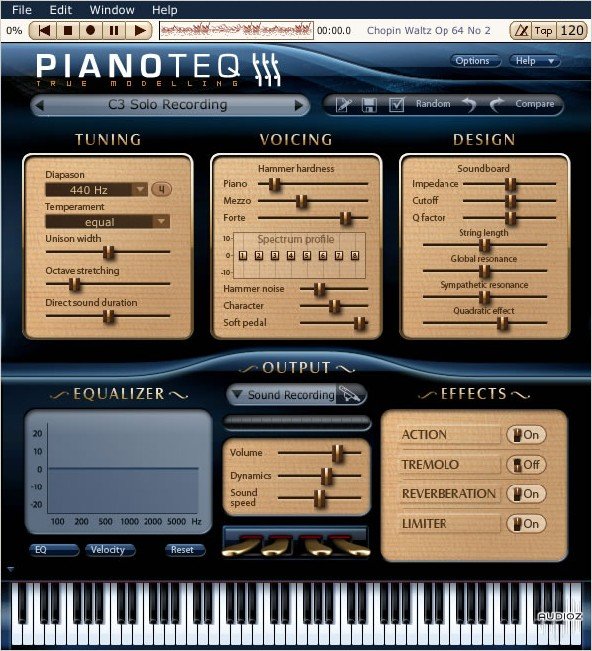Pianoteq Mac Crack
понедельник 07 января admin 54
Piano tuners occasionally employ 'stretch tuning'. The idea behind this is to make the piano sound a little sweeter (and, some say, more apparently in tune) by incrementally sharpening the upper octaves and flattening the lower ones by a small degree, resulting in a 'stretched' range from the bottom note to the top. (The effect is most pronounced at the top end.) Pianoteq 's 'octave stretching' control allows you to set the amount of stretch: a zero setting produces equal temperament, while the maximum setting makes the top notes sound noticeably sharp. A medium setting imparts some apparent 'brightness' of intonation to the high end without making it sound badly out of tune, but if you layer a stretch-tuned Pianoteq with other instruments, you're likely to notice a nasty tuning discrepancy in the top two octaves. A second tuning control governs the degree of unison tuning of the piano's virtual strings. Most piano notes have three strings which are hit simultaneously by one hammer, and when the three are out of tune they produce the characteristic 'honky tonk' pub piano sound. Pianoteq offers a 'unison width' setting which ranges from zero to 20, with an extremely lifelike honky tonk effect kicking in at around six.
Any questions regarding specific reviews, previews, or perspectives should be sent directly to the author of the piece. Contact information are provided on every.
Clone trooper armor pepakura files helmet 2. Interestingly, most of the main presets use a setting of just over one, and reducing that figure to zero makes the individual notes sound somewhat less lively. This seems to indicate that when it comes to piano tuning, a 100 percent perfect unison between the three strings may not necessarily be desirable. Having said that, we are talking about extremely subtle differences that will tend to go unnoticed in most listening situations! I compared Pianoteq to one of the best of the recent crop of sampled grands, and the difference was pretty dramatic. Both pianos sounded fine on simple pop/rock styles, handling big stately chords, slow melodies, octave bass lines and fast repeated chords with aplomb. But when it came to expressive improvised music, Pianoteq was much more playable — its notes sounded more connected than those of the sampled instrument, giving fast runs and phrases something of the silvery cohesion of a real piano.
The lack of discernible latency was also a huge plus. The only minor disadvantage of Pianoteq was that its tone arguably lacks a little overall sparkle, but that's easy to remedy with the on-board EQ. It could be argued that Pianoteq lacks features offered by certain sample-based piano titles, some of which contain more than one make of piano or alternative microphone positions. One even features a grand piano recorded in 5.1 surround! Modartt have not gone down this road, concentrating instead on producing a very accurate stereo modelled grand with a huge range of user-adjustable parameters.
Some of the videos and help analized are a simple a lost of time with instructions to nowhere. Install wifislax in virtualbox 1. In General the web offers answers to this problem relating to a minor conflictive vmware, but seems that this environment have similar problems. When I have an answer I will put here.
On the question of emulating different makes of piano, I see no reason why their ingenious modelling procedure could not be adapted to emulate the sound of (say) a Steinway, a Yamaha or a Bosendorfer grand. In fact, the company are already working on a couple of new pianos, though neither of them are based on the well-known makes I mentioned. Most keyboardists need a decent piano sound, and few of us can achieve it by rolling into a piano showroom and thrusting a holdall full of £50 notes at the manager. For studio musicians, composers, arrangers, programmers and even gigging keyboardists prepared to take their chances with an on-stage laptop, Pianoteq offers an affordable and creditable solution to the age-old digital piano problem. Although it can't take the place of an acoustic grand (no electronic simulation ever will), it brings the sound and touch of the real thing within closer reach. As ever, writing about piano sound is a subjective business, but in this case you don't have to take my word for it.
